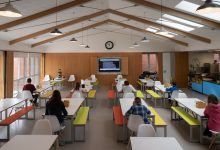Parent engagement matters in primary school

The phrase “parent involvement” in children’s learning may conjure images of parents in the classroom eagerly helping children to make Easter baskets or complete their readers. These are typical examples of parent involvement in preschools. But how is involvement fostered in the primary school years?
Parental involvement in children’s learning is beneficial. Research showsit leads to better educational, social, and emotional outcomes for children. In addition, a report from the Australian Research Alliance for Children & Youth (ARACY) has found parental involvement contributes to overall student positive attainment, behaviour and attendance at school.
However, as children grow up, the ways in which parents can be involved in their learning changes. While it is acknowledged that employment-related demands limit parents’ attendance during school times, the physical presence of parents in the classroom is no longer essential, or necessarily effective.
Changing parent engagement at primary level schooling
Regular face-to-face contact with teachers is more common in preschools than primary schools. As this changes, new ways of parent involvement can be created.
In primary school, contact is also more likely to be initiated by parents than teachers. Nonetheless, results from our research show parent involvement levels are lower at primary school level. Specifically, direct involvement in classroom activities, excursions and parent committees is rarer for parents in primary schools.
These changes occur for several reasons.
First, parents’ work schedules may restrict their availability throughout the day.
Second, although parents often need to physically come in to the classroom to drop children off at a preschool, this is less frequent in primary schools. Older children may take a bus or be dropped off at the school gate.
Third, parents’ direct involvement on school grounds wanes as children get older and most become more independent.
Above all, direct engagement isn’t necessarily effective as children pass through school.
Ageing and adjusting: re-imagining parental roles in learning
So how do parents transform their role of being “involved” as their children transition to primary school? It is important for teachers and parents to be aware that there is no one-size-fits-all approach.
A variety of opportunities should exist to allow families to support their children in meaningful ways. Some types of parent involvement will be less active and formal than others, and this is not a bad thing.
Evidence shows that when regular communication channels suit families’ needs and schedules, family-school partnerships are stronger. This in turn encourages children to learn outside of school.
This could mean that phone calls work best for some families, while emails, Skype sessions, text messages, or face-to-face meetings work better for others.
More schools are now using social media to create effective opportunities for indirect parent involvement. They often have Twitter feeds, and Facebook pages, and post images of students engaged in activities such as excursions, sporting events and shows. For parents who cannot attend such events, this sharing is inclusive and respectful.

A school website with a regularly updated photo gallery, and copies of the most recent newsletters and reminders, is also a useful resource for parents. This includes providing a space for feedback, comments and a variety of contact points that enable parent input.
Some schools are now using interactive technologies, such as parent-school wikis, blogs, and virtual chatrooms to engage parents. These allow parents to have regular contact and involvement with their children’s schooling.
These “virtual” strategies are the building blocks for parents to be aware of what is going on with their children’s education, while adjusting to the reduced need for their physical presence.
It is a crucial element of fostering better engagement with children in home learning environments, because it allows parents to ask nuanced questions about their children’s studies or school activities.
Practical tips for creating a positive home learning environment
Using these different ways of engaging in primary schooling, parents can then better encourage their children’s learning in the home environment. This is the most effective way that parents can be involved.
Research suggests that the quality of the home learning environment is linked to better cognitive outcomes in children.
Evidence also shows that parent engagement in children’s learning at home is more important than direct parent involvement in school. Considering a range of studies, ARACY states that the relative influence of the home environment on student achievement is 60%-80%, while the school environment accounts for 20%-40%.
Parent involvement in children’s home learning can be fostered in a variety of ways, including:
-
asking questions about what children are learning, encouraging and supporting children to complete homework;
-
helping to teach organisational and self-study skills, such as keeping notebooks organised, and creating time and space for learning activities;
-
showing an interest in children’s learning, listening to them talk about their day;
-
engaging with the information distributed by schools (via Facebook, email, website, etc); and
-
providing access to learning resources, such as trips to the library, access to internet, and materials to complete homework.
Most importantly, these strategies create a range of ways that connect the home and primary school environments. By being engaged and interested in their children’s activities outside the school, parents can be powerful supporters of their children’s learning.
![]() This piece was written by Laura McFarland, Lecturer in Early Childhood Studies, Charles Sturt University; Angela Fenton, Associate Head of School of Education, Lecturer, Charles Sturt University. The article was originally published on The Conversation.
This piece was written by Laura McFarland, Lecturer in Early Childhood Studies, Charles Sturt University; Angela Fenton, Associate Head of School of Education, Lecturer, Charles Sturt University. The article was originally published on The Conversation.







